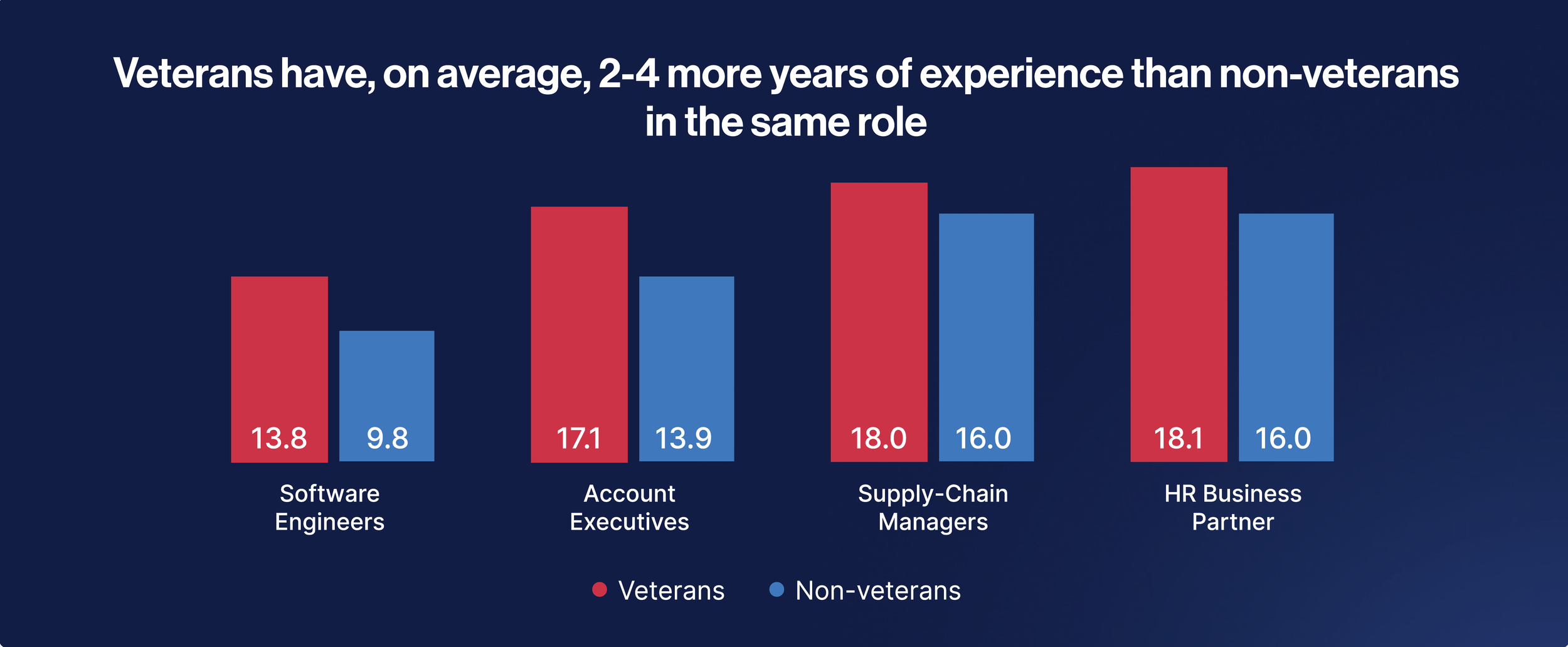Tim Best
CEO, RecruitMilitary
Heather Haag
Head of Veteran Initiatives, Findem
Podcast Episode Release Date: 17 November
Beyond the Article: Hear the full exclusive interview with RecruitMilitary’s CEO Tim Best and Findem’s Head of Veteran Initiatives, Heather Haag, at on the VCEO Podcast for more details on their report “Unlocking the Potential of Veterans in the Civilian Workforce”
Unlocking the Full Potential of Veteran Employees
Controlled Controllables, Leveraged, Resources, Network | Determined Mentorship, Championship, Significant Luck

The Veteran Employee Advantage: More Experience, Higher Performance
RecruitMilitary, one of the nation's leading organizations connecting employers with the military community, has recently partnered with Findem AI to conduct a comprehensive study on Veterans in the civilian workforce, aiming to provide statistical evidence on the value that Veterans bring to the civilian workforce. The data uncovered tells a story of a workforce that brings in exceptionally high-valuable workers for performance, innovation, and retention.
The Experience Edge
Across various career fields, Veterans have, on average, two to four years more experience than their non-Veteran counterparts in the same roles. This experience is particularly notable in customer-facing and innovation roles, where Veterans are 43% more likely to be top-performing salespeople and 23% more likely to hold patents and frequently publish research, often without having advanced degrees.
Another significant finding of the study was that Veterans from technical career fields, such as aircraft maintenance, had skills that translate incredibly well into engineering jobs. A unique finding here is that Veterans are 20% more likely to hold engineering jobs without a bachelor's degree, largely due to their on-the-job experience.
"When you have really highly skilled professionals coming out of those career fields... many times their skills translate incredibly well into hands-on true engineering jobs,” says Tim Best, CEO of RecruitMilitary.
Retention Advantage
In addition to Veterans bringing more experience to employers than their non-Veteran counterparts, Veterans are also more likely to stay with companies longer. Veterans are 31% more likely to remain in a job for four years or longer. These higher retention rates translate directly into a reduction in turnover costs, which typically range from 50% to 200% of an employee's annual salary.
"Every time we turn someone over, you're talking about $25,000 to $100,000 per employee for typical U.S. jobs,” says Tim. “That's a massive case study for the purpose behind retention".
Solving the Riddle To Unlock The Full Potential of Veteran Employees
Tim and Heather point out that both Veteran employees and companies must take intentional steps to maximize Veteran experience, leadership, and innovation, ultimately solving the promotion paradox.
Employer Recommendations: Strategy Over Initiative
For companies, treating Veteran hiring and retention as a strategic business imperative is essential, rather than just a compliance or feel-good initiative.
The study references an initiative by John Deere, which has partnered with RecruitMilitary, resulting in a 2.2 times higher Veteran promotion rate compared to the national average. They achieve this by deliberately outlining clear career paths, promoting various learning opportunities for growth, and intentionally establishing programs that foster a sense of community.
“It becomes a question of ‘why would you leave when you are not only happy and comfortable, you know the people around you, you've built that community?’” says Heather. “The opportunity to learn really goes back into mission and feeling like you belong and you're growing”.
Veteran Recommendations: Proactivity and Ownership
For Veterans and transitioning service members, it is essential to focus on career ownership and proactivity. Veterans must ask questions to help them understand existing career gaps and proactively work to make themselves visible. The advice is to maintain intellectual curiosity, excel in their current roles, and actively seek opportunities where they can make a meaningful impact.
“Understanding the challenges is there, so then you can understand how to navigate them,” advises Heather.
Leveraging A.I. to Bridge the Gap
A critical tool for bridging the military-to-civilian gap is Artificial Intelligence. Heather notes the significant role AI plays in translating military experience into corporate language. This technology streamlines the recruiting phase by optimizing digital profiles, making the initial hiring process more efficient for everyone.
"The beauty of AI right now is that you don't necessarily have to do it perfectly,” Heather says. “The AI is going to start doing that translation... But you can't, you can't cheat your way out of making sure you put the information out there to be then analyzed and highlighted and optimized".
Tim also recommends that Veterans use AI not just for self-promotion, but for self-assessment, helping them prepare for tough interviews. “Go in and have AI tell you why you're not fit for the role so you can war game it before you even go into the interview,” says Tim.
The Competitive Advantage Realized
The data provided by RecruitMilitary and Findem presents a compelling case for strategically investing in Veteran employees. It also addresses the common challenges faced by Veterans once they have landed a job and how employers can utilize this information to maximize a talent pool of statistically proven, highly skilled, and professional employees, thereby gaining a strong competitive advantage. Veterans don't need to be reinvented; they need to be understood in context.
Access the Full Report
Click the link to download the full report “Unlocking the Potential of Veterans in the Civilian Workforce” and see all the data and strategic recommendations.





